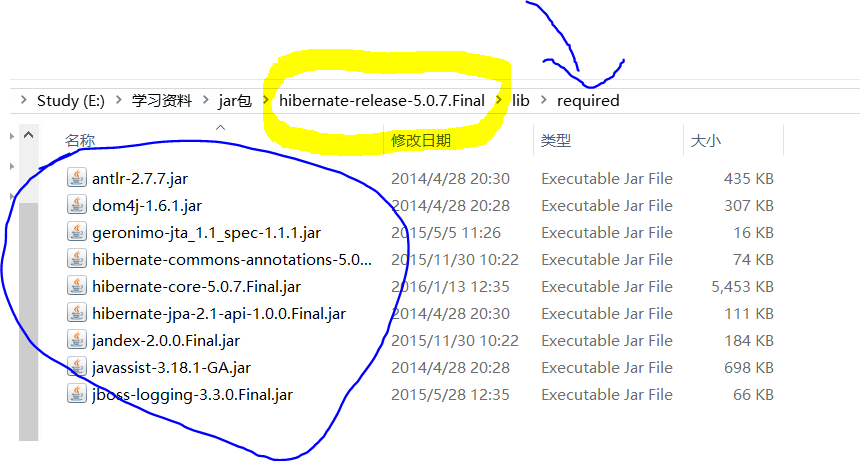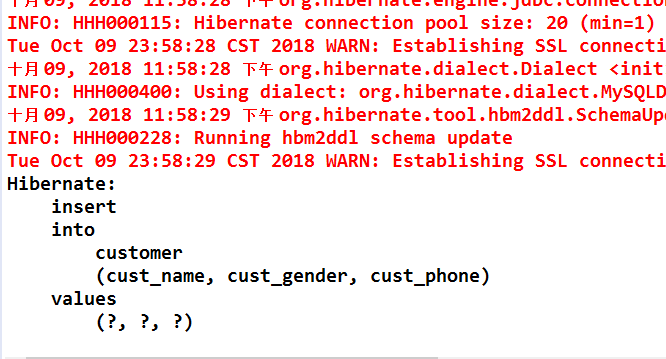1.导包
导入Hibernate最基本的包(不要忘记导入数据库驱动包了!)
下载文件名为黄色框框中的名称的压缩包在对应路径下,有个required包下的所有包就是必备的基本包

2.建表
1 USE TEST; 2 DROP TABLE IF EXISTS customer; 3 4 CREATE TABLE customer( 5 cust_id INT AUTO_INCREMENT PRIMARY KEY, 6 cust_name VARCHAR(30), 7 cust_gender VARCHAR(5), 8 cust_phone VARCHAR(20) 9 );
3.建实体类
1 package deep.entity; 2 3 import java.io.Serializable; 4 5 /** 6 * 用户实体类 7 * @author DeepSleeping 8 * 9 */ 10 public class Customer implements Serializable{ 11 12 private static final long serialVersionUID = 1L; 13 14 private int cust_id; 15 private String cust_name; 16 private String cust_gender; 17 private String cust_phone; 18 19 public int getCust_id() { 20 return cust_id; 21 } 22 public void setCust_id(int cust_id) { 23 this.cust_id = cust_id; 24 } 25 public String getCust_name() { 26 return cust_name; 27 } 28 public void setCust_name(String cust_name) { 29 this.cust_name = cust_name; 30 } 31 public String getCust_gender() { 32 return cust_gender; 33 } 34 public void setCust_gender(String cust_gender) { 35 this.cust_gender = cust_gender; 36 } 37 public String getCust_phone() { 38 return cust_phone; 39 } 40 public void setCust_phone(String cust_phone) { 41 this.cust_phone = cust_phone; 42 } 43 }
4.创建映射文件(Customer.hbm.xml)
①导入dtd文件约束
1 <!DOCTYPE hibernate-mapping PUBLIC 2 "-//Hibernate/Hibernate Mapping DTD 3.0//EN" 3 "http://www.hibernate.org/dtd/hibernate-mapping-3.0.dtd">
②导入本地dtd文件(这样就会有提示)
1:window --> preferencrs --> xml --> xml catalog --> add
2:location 选择 file system,然后选择你的本地dtd文件。(在下载的压缩包中搜索dtd也能找到)

3:key type 选择uri。
4:key 填入上述步骤中的"http://www.hibernate.org/dtd/hibernate-mapping-3.0.dtd"
③配置
1 <?xml version = "1.0" encoding = "UTF-8"?> 2 <!DOCTYPE hibernate-mapping PUBLIC 3 "-//Hibernate/Hibernate Mapping DTD 3.0//EN" 4 "http://www.hibernate.org/dtd/hibernate-mapping-3.0.dtd"> 5 6 <hibernate-mapping> 7 <!-- 建立类和表的一个映射关系 --> 8 <!-- 9 class标签:用来建立类和表的映射 10 *name属性:类中的全路径 11 *table属性:表名(如果类名和表名是一致的,那么table属性可以省略) 12 *catalog属性:数据库名称,可以省略 13 --> 14 <class name="deep.entity.Customer" table = "customer"> 15 <!-- 建立类中的属性与表中的主键的映射 --> 16 <!-- 17 id标签:用来建立类中的属性与表中的主键字段对应 18 *name属性:类中的属性名 19 *column属性:表中字段名(如果类中的属性名和表中的一致,可以省略) 20 *length属性:字段的长度 21 *type属性:类型 Java数据类型,Hibernate数据类型(默认),SQL类型 22 --> 23 <id name = "cust_id" column = "cust_id"> 24 <!-- 主键生成策略 --> 25 <generator class="native"></generator> 26 </id> 27 28 29 <!-- 建立类中的普通属性与表中的字段的映射 --> 30 <property name="cust_name" column="cust_name"/> 31 <property name="cust_gender" column="cust_gender"/> 32 <property name="cust_phone" column="cust_phone"/> 33 34 </class> 35 </hibernate-mapping>
5.创建Hibernate的核心配置文件(hibernate.cfg.xml)
在src目录下创建hibernate.cfg.xml文件
与上述步骤一致,导入约束,导入本地
1 <!DOCTYPE hibernate-configuration PUBLIC 2 "-//Hibernate/Hibernate Configuration DTD 3.0//EN" 3 "http://www.hibernate.org/dtd/hibernate-configuration-3.0.dtd">
1 <?xml version = "1.0" encoding = "UTF-8"?> 2 <!DOCTYPE hibernate-configuration PUBLIC 3 "-//Hibernate/Hibernate Configuration DTD 3.0//EN" 4 "http://www.hibernate.org/dtd/hibernate-configuration-3.0.dtd"> 5 6 <hibernate-configuration> 7 <session-factory> 8 <!-- 必要的配置信息:连接数据库的基本参数 --> 9 <property name="hibernate.connection.driver_class">com.mysql.jdbc.Driver</property> 10 <property name="hibernate.connection.url">jdbc:mysql:///test</property> 11 <property name="hibernate.connection.username">root</property> 12 <property name="hibernate.connection.password">123456</property> 13 14 <!-- Hibernate的属性 --> 15 <!-- Hibernate的方言:作用,根据配置的方言生成相应的SQL语句 --> 16 <property name="hibernate.dialect">org.hibernate.dialect.MySQLDialect</property> 17 <!-- Hibernate显示SQL语句: --> 18 <property name="hibernate.show_sql">true</property> 19 <!-- Hibernate格式化SQL语句(不然显示的就是一行,不方便阅读) --> 20 <property name="hibernate.format_sql">true</property> 21 <!-- Hibernate的hbm2ddl(数据定义语言:create drop alter ...) 属性 --> 22 <!-- 23 hbm2ddl.auto的取值 24 *none: 不用Hibernate自动生成表 25 *create:每次都会创建一个新的表(测试) 26 *create-drop:每次都会创建一个新的表,执行程序结束后删除这个表(测试) 27 *update:如果数据库中有表,使用原来的表,如果没有表,创建一个新表,可以更新表结构 28 *validate:只会使用原有的表,对映射关系进行校验 29 --> 30 <property name="hibernate.hbm2ddl.auto">update</property> 31 32 33 <!-- Hibernate加载映射 --> 34 <mapping resource="deep/entity/Customer.hbm.xml"/> 35 </session-factory> 36 </hibernate-configuration>
6.测试
1 package deep.test; 2 3 import org.hibernate.Session; 4 import org.hibernate.SessionFactory; 5 import org.hibernate.Transaction; 6 import org.hibernate.cfg.Configuration; 7 import org.junit.Test; 8 9 import deep.entity.Customer; 10 11 /** 12 * 使用Hibernate保存数据 13 * @author DeepSleeping 14 * 15 */ 16 public class demo { 17 18 @Test 19 public void save(){ 20 21 //1.加载配置文件 22 Configuration cfg = new Configuration().configure(); 23 //2.创建一个SessionFactory 24 SessionFactory sessionFactory = cfg.buildSessionFactory(); 25 //3.创建Session对象,Session对象类似Connection 26 Session session = sessionFactory.openSession(); 27 28 //4.开启事务 29 Transaction tx = session.beginTransaction(); 30 31 //5.执行相关操作 32 Customer customer = new Customer(); 33 customer.setCust_name("Hibernate测试"); 34 session.save(customer); 35 36 //6.事务提交 37 tx.commit(); 38 //7.释放资源 39 session.close(); 40 } 41 42 43 44 45 }

